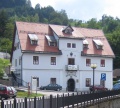UNESCO World Heritage Sites in Slovenia
In 1986 the Škocjan Caves became the first Slovene landmark inscribed onto a UNESCO World Heritage Site list. The largest known underground canyon in the world, the Škocjan Caves system is truly an example of extraordinary natural beauty. The remains of two prehistoric pile-dwellings from the Ljubljansko Barje marshlands were invited to join the transnational heritage site "Prehistoric Pile-Dwellings in the Alpine Area", which comprises a selection of 111 of a total 1,000 archaeological sites in six countries around the Alps (Switzerland, Austria, France, Germany, Italy and Slovenia). In June 2011, the pile-dwellings were unanimously accepted to the UNESCO World Heritage List. The latest addition is the Heritage of Mercury. Almadén and Idrija, listed in 2012.
Other Slovene sites submitted on the UNESCO tentative list include the Classic Karst, the Fužina Hills in Bohinj, and the Franja Partisan Hospital, the beech forests, and the Plečnik arhitectural heritage and The Walk of Peace from the Alps to the Adriatic – Heritage of the First World War. }}
Sites on the tentative list
- The Fužina Hills in Bohinj (added in 1994), are part of Triglav National Park and are unique for alpine herding on high pastures with special farm structures primarily hayracks named Kozolec in Slovene and also types of pasture cottages where milk and diary products are made. People's customs and festivities are of ethnological importance and are connected with high mountain herding.
- The Classic Karst (added in 2015), region in western Slovenia named Kras where the term Karst originated. It is limestone plateau known for various karst phenomena such as caves, abysses, sinkholes and intermittent lakes.
- The Franja Partisan Hospital (added in 2000) is Second World War hospital comprised of 13 wooden buildings. Complex was set up in the period from December 1943 to May 1945 and was among the best equipped clandestine partisan hospitals with an operating room, X-ray apparatus, an invalid care facility, and a small electric plant. In 2007 floods devastated the site. A complete renovation finished in May 2010 when the hospital reopened for visitors. In 2015 Franja has received a renowned award presented by the Committee for European Heritage, the European Heritage Label.
- The beech forests related project focusing on an outstanding example of undisturbed, complex temperate forests, nominated by the Municipality Kočevje, the Municipality of Ilirska Bistrica and the Municipality of Loška dolina. Extension to the Joint World Heritage Property Primeval Beech Forests of the Carpathians (Slovak Republic and Ukraine) and Ancient Beech Forest of Germany, added in January 2015.
- The Czech Republic initiated the nomination of the The timeless, humanistic architecture of Jože Plečnik in Ljubljana and Prague for the inscription of on the UNESCO World Heritage List. Added in January 2015.
- The Walk of Peace from the Alps to the Adriatic – Heritage of the First World War covers the area of the Isonzo Front with many important monuments and ruins, including military cemeteries, air-raid cavern shelters, ditches, ossuaries, chapels, monuments, outdoor museums and other historic elements. Added in 2016.
See also
- Slovenia National Commission for UNESCO
- Škocjan Caves World Heritage Site
- Franja Partisan Hospital
- Idrija Municipal Museum
- Triglav National Park
- Walk of Peace in the Soča Region Foundation
External links
- UNESCO Slovenia website (in Slovenian)
- Slovene sites on the UNESCO World Heritage Tentative List
- Information on Slovenia as a State Party to UNESCO
- UNESCO World Heritage Centre website
- Article "Pile-dwellings in the Ljubljansko Barje on the UNESCO World Heritage List" on Slovenia.si
- Prehistoric Pile Dwellings around the Alps website
- Brochure about the Pile Dwellers of the Ljubljansko barje
Articles in category "UNESCO World Heritage Sites in Slovenia"
The following 11 pages are in this category, out of 11 total.
Media in category "UNESCO World Heritage Sites in Slovenia"
The following 17 files are in this category, out of 17 total.
- Franja Partisan Hospital 2010 Interior of doctors' room.jpg 2,448 × 3,264; 1.95 MB
- Franja Partisan Hospital 2010 Operating room.jpg 3,264 × 2,448; 1.9 MB
- Franja Partisan Hospital 2015 barracs Photo Luka Kalan.jpg 1,920 × 1,305; 2.02 MB
- Idrija Mine Museum 2006 entrance.jpg 1,299 × 1,173; 218 KB
- Miner's House Idrija 2007 fireplace.JPG 2,048 × 1,536; 395 KB
- Municipality of Idrija 1689 Valvasor.jpg 955 × 768; 187 KB
- Plecnik Collection 2015 reception room Photo Matevz Paternoster.jpg 2,500 × 1,875; 1.42 MB
- Plecnik House 1923 Karunova Ljubljana architectural design.jpg 7,036 × 3,181; 5.66 MB
- Plecnik House 2015 entry porch Photo Matevz Paternoster.jpg 2,500 × 1,875; 1.44 MB
- Plecnik House 2015 exterior Photo Andrej Peunik.jpg 2,000 × 1,333; 2.93 MB
- Plecnik House 2015 interior Photo Matevz Paternoster.jpg 2,500 × 1,875; 1.04 MB
- Plecnik House 2015 renovated studio Photo Matevz Paternoster.jpg 2,500 × 1,875; 1.3 MB
- Triglav National Park 2014 Kluze Fortress 01.jpg 5,472 × 3,648; 10.39 MB
- Walk of peace 2006 Italian charnel house above Kobarid Photo Zeljko Cimpric.jpg 5,266 × 3,547; 3.08 MB
- Walk of Peace 2006 Outdoor museum Kolovrat Photo Zeljko Cimpric.JPG 3,264 × 2,448; 5.09 MB
- Walk of Peace 2011 Monfalcone Parco tematico della Grande Guerra.jpg 3,264 × 2,448; 3.08 MB



















